Diabetes Medication Comparison: Find the Right Treatment for Your Needs
When you start looking at diabetes medication comparison, the process of weighing different drugs used to control blood sugar, their benefits, drawbacks, and costs. Also known as drug comparison for diabetes, it helps patients and clinicians pick the right regimen. Metformin, a first‑line oral agent that lowers glucose production in the liver often shows up as the baseline option. Insulin, the injectable hormone that replaces or supplements what the pancreas can’t produce enters the picture when blood sugar stays high despite pills. GLP‑1 agonists, injectable drugs that boost insulin release and curb appetite add weight‑loss benefits, while SGLT2 inhibitors, oral tablets that force the kidneys to dump excess glucose in urine bring heart‑protective effects. Together these entities form the core of any thorough diabetes medication comparison.
Understanding how these drug classes interact creates a clear semantic chain: diabetes medication comparison encompasses efficacy, side‑effects, and cost. It also requires knowledge of patient‑specific factors like kidney function, weight goals, and cardiovascular risk. For example, a person with mild kidney disease may lean toward GLP‑1 agonists over Metformin, while another with heart failure might benefit more from an SGLT2 inhibitor. The choice isn’t just about blood‑sugar numbers; it’s about how each medication fits into a broader health picture.
Cost is another pillar of comparison. Generic Metformin can be bought for a few dollars a month, making it the most affordable option for many. Insulin prices, however, vary widely by brand and delivery system, and they often dominate a patient’s medication budget. GLP‑1 agonists and SGLT2 inhibitors sit in the mid‑to‑high range, but many insurance plans now cover them because of their proven long‑term benefits. When you line up price, efficacy, and safety side by side, the trade‑offs become easier to see.
Side‑effects also shape the decision tree. Metformin commonly causes mild gastrointestinal upset, which most patients outgrow. Insulin carries the risk of hypoglycemia, especially if dosed aggressively. GLP‑1 agonists may trigger nausea or vomiting, while SGLT2 inhibitors can increase the chance of urinary tract infections. Knowing which side‑effect profile aligns with a patient’s lifestyle helps narrow the list quickly. In practice, doctors often start with Metformin, add an SGLT2 inhibitor for added heart protection, and consider a GLP‑1 agonist if weight loss becomes a priority.
Beyond the four main drug families, you’ll also encounter newer combos like fixed‑dose Metformin‑SGLT2 tablets or insulin‑GLP‑1 dual‑action pens. These hybrids aim to simplify dosing while delivering the benefits of each component. When you compare them, you’re really comparing convenience against flexibility. Some patients love the “one‑shot” approach; others prefer the ability to tweak each drug’s dose separately.
All of these points—efficacy, cost, side‑effects, convenience—form the backbone of a solid diabetes medication comparison. Below you’ll find detailed articles that dive into each drug class, break down pricing across pharmacies, and offer real‑world tips for staying on track with your regimen. Whether you’re just diagnosed, managing diabetes at work, or navigating pregnancy with type 2 diabetes, the collection below gives you practical guidance to make an informed choice.

Rybelsus (Semaglutide) vs. Other GLP‑1 Drugs: Complete Comparison
A detailed side‑by‑side review of Rybelsus (semaglutide) versus other GLP‑1 drugs, covering efficacy, safety, cost and how to choose the right option.
